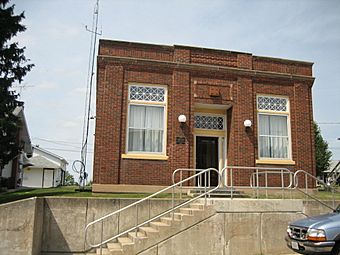People's State Bank (Orangeville, Illinois) facts for kids
Quick facts for kids |
|
|
People's State Bank
|
|
 |
|
| Location | 300 W. High St., Orangeville, Illinois |
|---|---|
| Area | less than one acre |
| Built | 1926 |
| Architectural style | Commercial style, Classical Revival |
| NRHP reference No. | 04000868 |
| Added to NRHP | August 20, 2004 |
The People's State Bank building is a historic place in Orangeville, Illinois, a small village in Stephenson County, United States. It was built in 1926 when two banks in Orangeville joined together. The bank operated for a few years but closed in 1932. This happened because of the Great Depression, a time when the economy was very bad. Also, a main road was moved away from downtown Orangeville. The building looks like a mix of Commercial style and Classical Revival architecture. These styles were popular for banks back then. In 2004, the People's State Bank building was added to the U.S. National Register of Historic Places.
Contents
Where is the People's State Bank?
The People's State Bank building is in Orangeville, Illinois. This small village has about 800 people. It is located about two miles (3 km) from the border between Illinois and Wisconsin. The bank building is in the main business area of Orangeville. This area is along High Street and Main Street. High Street goes uphill from the Richland Creek. Many old buildings from the 1800s are on this street.
At the top of High Street, you can find the Central House. This building is also on the National Register of Historic Places. In fact, four out of five historic buildings in Orangeville that are on the National Register are on High Street. These include the Union House and the Orangeville Masonic Hall. Other old buildings nearby are the Musser Building, built in 1888, and the Wagner Building from 1906.
History of the Bank Building
The People's State Bank building was built in 1926. Before this, Orangeville was a busy place for businesses. Two of the three banks in Orangeville decided to merge and create the People's State Bank.
However, things started to change. In 1928, just before the Great Depression began, a major road was moved. Illinois State Highway 74 (now Illinois Route 26) was rerouted. It now went through the eastern part of Orangeville, bypassing the downtown business area. Even though the main road no longer passed through downtown, many businesses managed to stay open at first. But by 1928, it was clear that the business community in Orangeville was shrinking. The new road, along with the Great Depression, continued to hurt the village. In 1932, the People's State Bank closed its doors. It was the last bank still open in Orangeville.
After the bank closed, the American Legion Post #720 bought the building. It was used as their meeting hall until 1956. Then, some local people bought the building. They wanted to open a bank in Orangeville again. From 1956 until 1980, the building was once again a bank. It was called the Orangeville Community Bank. In 1980, a business that repaired and sold radios bought the building. This business closed in August 2002, and the building became empty. An organization called A Community Together bought the bank building. They then sold it to John and Caryl Buford in October 2003.
What Does the Bank Building Look Like?

The People's State Bank building was designed in the Commercial style of architecture. It also has many details from the Classical Revival style. This was a very popular look for bank buildings at that time. The building has one story and sits on a strong concrete foundation. Its walls are 12 inches (30 cm) thick, and it has a full basement.
The Classical style details are shown through the use of brick, glass, and concrete. The building has a simple design but shows several Classical Revival features. For example, it is built with strong masonry, which makes it look sturdy. It also has a balanced, symmetrical design. The brick sections on the walls look like pilasters, which are flat columns. There are also semi-circular fanlight windows above the windows on the east and west sides. The large lobby inside the bank also made customers feel that the bank was solid and trustworthy.
The building is shaped like a rectangle, measuring 30 feet (9 m) by 64 feet (20 m). It is made of brick and has terrazzo flooring, which is a type of mosaic floor. This building is the most decorated commercial building in downtown Orangeville. It is located on the second highest spot in the area. The main entrance is a large wooden door with glass panels. It is set back from the front of the building and is in the center of the symmetrical south (front) side. The original door has windows on the sides called sidelights. Above the door is a transom window with a diamond pattern. On each side of the main doorway, there is a window with the same diamond-patterned transom.
Why is This Building Important?
The People's State Bank building was the last big commercial building built in the historic downtown area of Orangeville, Illinois. Before World War II, Classical Revival architecture was very popular for business and public buildings. The People's State Bank is a good example of a one-story commercial building with Classical details. Because of its special architecture, the People's State Bank building was added to the U.S. National Register of Historic Places on August 20, 2004.



